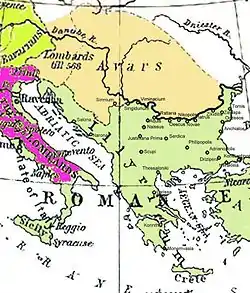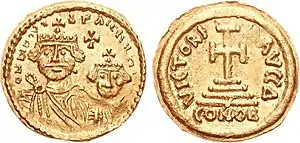آوارهای اوراسیایی
آوارهای اوراسیایی مردمانی کوچنشین با ترکیبی از نژادهای گوناگون بودند. بر پایه پژوهشهای آندراس رونا تاس قوم آوار در آسیای میانه در قرون باستان از ادغام چند قبیله شکل گرفتهاست.[8] در قرن ششم میلادی تاریخشناس مناندر پروتکتور اشاره کرد که زبان آوارها شبیه به زبان هونها بودهاست. این نظریه باعث تقویت نظریهای میشود که زبان آوارها را از شاخه اوغور زبانهای ترکی میداند.[9] به تازگی برخی پژوهشها اشاره کردهاند که آوارها به یکی از زبانهای ایرانی سخن میگفتهاند.[10] همچنین با کشف برخی اسکلتهای مغولی در گورهای قدیمی آوارها برخی پژوهشگران ابراز داشتهاند که ریشه آوارهای اروپا به مغولها برمیگردد هرچند این تئوری توسط دیگران مورد مناقشه قرار گرفتهاست.[11]
Pannonian Avars | |||||||||||||||
|---|---|---|---|---|---|---|---|---|---|---|---|---|---|---|---|
| ۵۶۷–after 822[1] | |||||||||||||||
 Avar Khaganate around 582–612 AD. | |||||||||||||||
| زبان(های) رایج | Proto-Slavic (lingua franca)[2] Mongolic, Turkic or Tungusic languages (possibly, partially)[3][4][5] | ||||||||||||||
| دین(ها) | Originally Shamanism and Animism, Christianity after 796 | ||||||||||||||
| حکومت | Khanate | ||||||||||||||
| Khagan | |||||||||||||||
| تاریخ | |||||||||||||||
• بنیانگذاری | ۵۶۷ | ||||||||||||||
• Defeated by Pepin of Italy | ۷۹۶ | ||||||||||||||
• فروپاشی | after 822[6] | ||||||||||||||
| |||||||||||||||

جستارهای وابسته
منابع
| در ویکیانبار پروندههایی دربارهٔ آوارهای اوراسیایی موجود است. |
- Carl Waldman & Catherine Mason, 2006, Encyclopedia of European Peoples, Volume 2, New York: Infobase Publishing, p. 769.
- Curta, Florin (2004). "The Slavic lingua franca (Linguistic Notes of an Archeologist Turned Historian)" (PDF). East Central Europe/L'Europe du Centre-Est. 31 (1): 132.
- Curta, Florin (2004). "The Slavic lingua franca (Linguistic notes of an archaeologist turned historian)". East Central Europe/L'Europe du Centre-Est. 31: 125–148. Retrieved 29 May 2015.
By contrast, there is very little evidence that speakers of Slavic had any significant contact with Turkic. As a consequence, and since the latest stratum of loan words in Common Slavic is Iranian in origin, Johanna Nichols advanced the idea that the Avars spoke an Iranian, not a Turkic language.
- Helimski, E (2004). "Die Sprache(n) der Awaren: Die mandschu-tungusische Alternative". Proceedings of the First International Conference on Manchu-Tungus Studies, Vol. II: 59–72.
- Fuente, José Andrés Alonso de la. "Tungusic Historical Linguistics and the Buyla (a.k.a. Nagyszentmiklós) Inscription". academia.edu.
- Carl Waldman & Catherine Mason, 2006, Encyclopedia of European Peoples, Volume 2, New York: Infobase Publishing, p. 769.
- CNG Coins
- Hungarians and Europe in the Middle Ages. CEU press
- K.H. Menges, "Altaic people", دانشنامه ایرانیکا, v, p. 908-912, Online Edition
- Florin Curta. The Slavic Lingua Franca. Quotation: "There is very little evidence that speakers of Slavic had any significant contact with Turkic. As a consequence, and since the latest stratum of loan words in Common Slavic is Iranian in origin, Johanna Nicols advanced the theory that the Avars spoke Iranian, not Turkic."
- E. H. Parker: A Thousand Years of the Tartars, ISBN 978-0-7103-0746-0
This article is issued from Wikipedia. The text is licensed under Creative Commons - Attribution - Sharealike. Additional terms may apply for the media files.